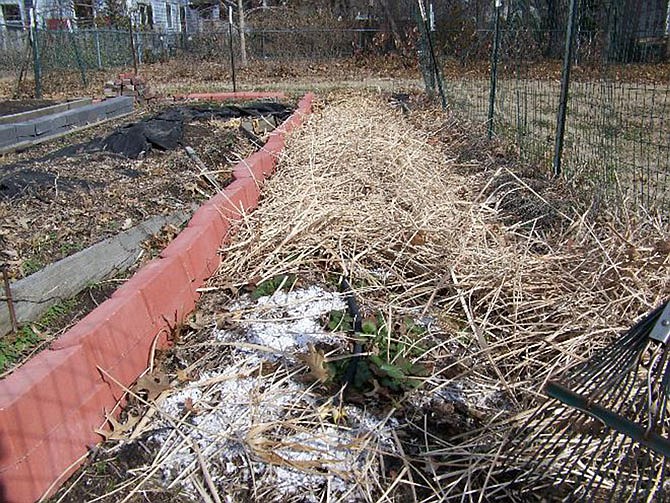Vegetables
As the weather cools off, you can focus on two principles: doing what you can to extend warm season vegetables' productivity and caring for newly planted cool season vegetables (or planting the few for which there is still time).
For all warm season vegetables (i.e., cucurbits, tomatoes, peppers and green beans), frost protection may be worthwhile but only if it warms up for a decent spell after a cold snap. Once the cool weather sets in, coupled with shorter days, it seems like production comes to a halt. Finishing off the ripening of fruit already formed is the most worthwhile once into October. When protecting from frost, remember it is only practical to hold the heat in above the soil for 11/2-2 feet. With that in mind, one year I cut the strings for my tomatoes (supported in the stake and string method). I then pulled the stakes and let them collapse to the ground and threw a tarp over them for the onset of three cold nights. It then warmed up for about two weeks. For cucumbers, zucchini and melons, you can still get some decent pickings; fruit setting on the ground will ripening quicker due to the soil warmth.
Watch the cucurbit vegetables for cucumber beetles, and continue to control them and look for powdery mildew. Consider applying a fungicide or a baking soda spray for control, especially if it becomes severe.
Providing some supplemental fertilization to warm season vegetables should be considered in early September, especially if this wasn't done in August. As there is not a lot of time left, using a liquid product once or twice might be the best approach.
Direct seeding in early September of greens and lettuces will still provide good results, but is really too late for carrots or transplanting cole crops. Really short season crops like turnips, Napa cabbage and baby bok choi may still finish. Be sure to thin root crops, cabbage or anything you want to size up. To establish spinach for overwintering, plant it by the end of September. Garlic should be planted at the end of October or early November, similar to a tulip bulb.
Fruits
Later season apples and many pears will ripen into September and October. Especially for apples, and even some for pears, is the tendency for strong bearing one year and a light crop the following. Older trees are still in a pattern where even years are strong, so this year should be a good apple year.
Persimmons will ripen into October, if not even November. Native Missouri trees and any cultivars from them are astringent, thus they need to mature fully before picking, or your mouth will pucker up upon consuming. There are two Asian cultivars rated for Zone 6; put in a protected location if planting in Zone 5b. These are non-astringent; Ichi-ki-kei-jiro is available on a dwarfing rootstock, but Saijo is not.
Flowering annuals
Downy mildew of impatiens is a new disease for the Midwest. Varieties from cuttings resistant to this disease were just introduced in 2015 (i.e., Bounce Pink Flame PPAF Balboufink and SunPatiensSpreading Shell Pink). Because the causal organism favors cool, moist conditions, spring and fall are the seasons when symptoms most likely would be observed in Missouri landscapes. If you think you may have plants that were or may be infected, get more information about this disease, as it can overwinter or be harbored by other plants and thus can return the next year.
Do you like pansies but find their finicky overwinter survival in Missouri vexing? Consider trying pansies with a spreading habit (i.e., from the Cool WaveTM series). Gaps can be filled in. Planting by early October should allow them to establish well enough so they won't frost heave.
Lawns
The conundrum for those wanting to improve their lawn - how to overseed and apply a weed killer? Fall is the best time to do both.
Fall seeding of cool season grasses is best earlier in September, so the new plants can establish well for the winter. By doing so early you can come back later with a herbicide and fertilizer granular combination in October. One should not apply this type of product for about three weeks prior or after seeding (check the label). Perennial broadleaf weeds are best controlled in fall (as opposed to spring), as they are translocating food reserves from the tops to the roots them.
What about winter annuals like henbit (purple-flowered spring weed)? Apply Gallery herbicide in late September or a three-way premix postemergence herbicide in late fall. But Gallery can only be used safely over the top of new lawn seedings after seedlings are established (three-leaf stage and side shoots are visible). This may take up to a month after seeding.
Zoysiagrass disease alert! Large patch is the most prevalent disease for Zoysia lawns and the time to prevent the disease is with a fungicide application in the fall, as the weather transitions to cooler, moister conditions. A spring application can help but is not considered as effective.
James Quinn is a horticulture specialist for University of Missouri Extension active in the central area of the state. He is an avid gardener and enjoys his position to provide advice and programming in horticulture.

